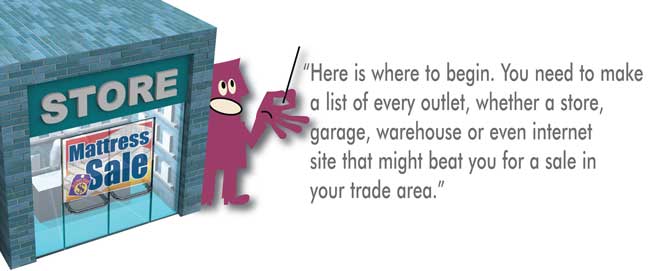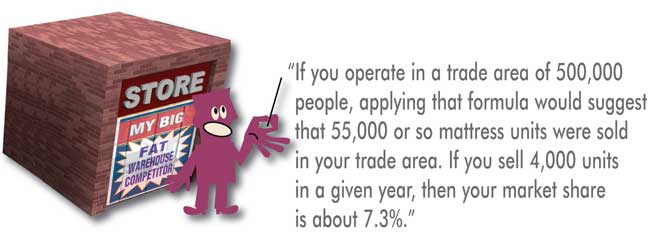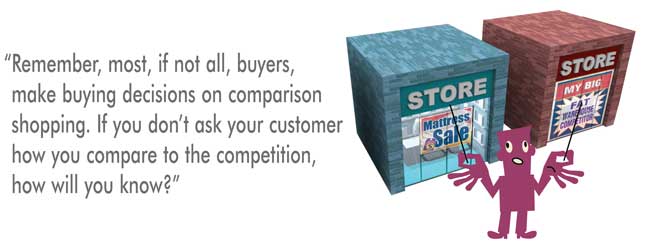How often do you think about your competition? Is it mostly when you have just lost a sale that you probably should have made? How often does the presence of your competition affect your day to day operating strategy? How well do you really know them? Not just the guys down the street; I mean how well do you know ALL of your competition?
Allow me to propose a thought exercise. Bear with me on this one. What if you had no competition? What if your store was the only store in town that sold mattresses and bedding? What if you were the only furniture and bedding outlet within 200 or more miles? What if your store was the only place customers could buy mattresses and furniture, period?
Would you make all the sales? You might answer, “How could I not make all the sales, if I had no competition?”
It stands to reason, then, that the only reason you DON’T make every sale is the presence of competition.
I know of some store owners who say, “We don’t worry about the competition. We operate our way, and that’s the way it is. You can’t control what the competition does; we have our own philosophy of how we do business; we adopt the policies that reflect that philosophy and do the best we can.”
While that is a noble sounding sentiment, and there is no denying that all business owners should have a philosophy by which they run their enterprise, the store owner who “turns the other cheek” to the competition is walking a very precarious path.
So, now let’s get to the point of our little thought exercise. Its point is to focus your attention on the only obstacle that stands in way of you making ALL the sales.

What To Do About Your Competition?
The goal of every store owner, even if it is practically unattainable, should be to make ALL the sales (in his or her merchandise category). Since we’ve already identified one of the major roadblocks to this goal as your competition, it should make sense to try to do something about this roadblock. So, what do you do?
Here are four categories to dissect, analyze and thereby, plan an attack.
- Identify your competition.
- Profile your competition.
- How do I get this information?
- How do I stack up versus my competition? In other words, how does the customer perceive my store vs. my competition? How can I improve to beat the competition? How do I measure success against my competition?
The goal of this exercise is to not just know your competition, but to know them as well as you do your own store.
Identify Your Competition
To explain it very simply, your competition is ANYBODY and EVERYBODY who sells, in your trade area, ANY product that might even remotely compete with ANY product that you sell in your store. Products you sell in your store are not just confined to your floor models, but also special catalog orders, or even sales you might make over the internet. If you do not recognize or believe or act on this basic truth, you will lose sales.
Here is where to begin. You need to make a list of every outlet, whether a store, garage, warehouse or even an internet site that might beat you for a sale in your trade area. These competitor outlets don’t even necessarily have to be located in your trade area. If you are located in a peripheral market (meaning a smaller market within 150 miles of a major trade area), I guarantee that your smaller market will be invaded by one or more big players from the major trade area. These big players will advertise in your market area, and they will deliver to your market area. That means you can ignore them only at your own peril. And, don’t fall victim to the old worry that “we can’t beat those guys! They have too much buying power! They sell too cheap!” You can beat them if you want to; even though you may have to give a little on those “sacred margin cows.”
Once you have made a list of all possible competitors, I recommend that you give a “difficulty rating” to each and every one of them. I usually define my ratings as follows:
- Primary or Category One competitors – These are outlets that present a similar profile to your store. They offer a product mix very much like your store, with similar pricing, merchandising and policies. They directly target your customer and they operate in your trade area.
- Secondary or Category Two competitors – These are outlets in your trade area who may offer similar looking products, but target a somewhat different customer. For example, if you offer a full range of bedding at popular prices, this secondary competitor might offer only a small selection of low-end, non-brand name products. Or, at the opposite end of the spectrum, they might offer only super-premium or high-end products. Or, they might offer similar products and prices, but only a limited selection, or only a part of your total selection.
- Tertiary or Category Three competitors – These could include mass merchandisers in your trade area, such as membership club stores, big chain groceries or department stores who think they also need to be in the furniture and bedding business. They might also include the aforementioned “big players” in a distant major market area.
- All other competitors – This might include internet sites that offer to ship into your trade area.
No matter how you rate them, any one of these outlets can and will beat you occasionally for a sale, especially if you pretend that they are not really your competition.

Profile The Competition
When we say “profile” your competition, we mean develop a file or “dossier” on each one. Each file should include specific information, as follows:
Name of the Store: This one is the title for your file. Now fill it up with the competitive intelligence your salespeople need to know.
Location of the Store: Jot down the street address, city, and preferably an area map, showing the competitor’s location relative to yours, including the exact distance from your store (or warehouse). It is a good idea to keep a city or area map in the office or break room with a pin locating each of your competitors. If you have an out of town “big player” who tries to invade your trade area, put a marker in the margin of your map.
Owner: Is this a locally owned store? Is it part of a small chain, or part of a large national chain? What other businesses does the owner operate? How much experience does the owner have in the mattress and furniture business? Is he hands-on or absentee? Does he work the showroom floor?
How old is the business? How long have they been in business? Is it multi-generational ownership and management?
Theme of the store: Is it a full line furniture store, specialty mattress store, warehouse, garage, internet?
Which manufacturers are represented on the floor, and in what concentration? It is a good idea to know not only what manufacturers they carry now, but which ones they have carried for the last 5 years. Some stores shuffle vendors in and out. What is their relationship with their suppliers? What kind of volume do they do with each manufacturer? How often do they get shipments and how large are their shipments?
Product list: Ideally, you should have a complete list of their products, with names and specifications. This list will probably have to be obtained piece by piece as you collect information from customers, mystery shoppers, competitor advertising, etc.
How do they advertise? In what media do they specialize? How often and how extensive are their ads? Do you have an approximate idea of their advertising budget? What is the theme of their advertising? Do they advertise “best price guaranteed” or “half-off” sales?
How much inventory do they keep on hand? Are they frequently out of stock, or can they honor a “buy it today, sleep on it tonight” promise with all or most of their SKUs?
What kind of financing do they offer? Do they have long-term Same As Cash programs? Do they offer in-house credit or credit to high risk customers?
What is the theme of their policies? Do they offer free delivery, free pick-up of the old mattress, comfort exchanges, price guarantees, or layaway? How attractive is their layaway program?
How many salespeople do they employ during the week? How many salespeople do they have on Saturday? How well trained are their salespeople? How do they pay their salespeople; commission, salary, or both? Do they have a lot of turnover with their sales staff? Note: I always use number of salespeople to give me a very rough idea of average monthly volume for the store. Most stores allocate one RSA to a certain dollar value of monthly sales (for example $40,000 per month per RSA). This can vary, of course.
How big is the store in square feet? You can step it off from outside, or count ceiling tiles. How many SKUs do they carry on the floor?
What is their demographic appeal? Who shops there? Is it a different or similar customer mix to your store?
What are their marketing and sales practices? Do they promote cheap products? Do they use low-ball pricing? Do they have flexible pricing; meaning, will they negotiate and drop the price to make a sale? If so, how low will they go? Can you determine the lowest margin they will accept on any given deal?
Reputation: What kind of local reputation do they have? Are their business practices suspicious or do they come under a lot of criticism from customers or reps? Do they seem to be ethical or unethical?
Attitude: Are they a market leader or follower? Do you find yourself responding to their actions or do they respond to yours and try to copy what you are doing? How tough are they to beat? Do you consistently lose sales to them?
This is a pretty extensive list of characteristics that describe each of your competitors, but it does not claim to be comprehensive. You can use this list to compile a standardized blank form and fill in the blanks for each competitor. With these forms, you then have a check list of what you know and what you don’t know about each of your competitors.
How Do You Fill In The Blanks?
Gathering information (or, intelligence, if you prefer) is a tedious, time-consuming project that really never ends. Just as with your store, things are always changing with the competition, and you need to keep up with these changes.
The first place to look is their advertising. I’m always surprised at how little attention most store owners pay to the advertising of their competition. Advertising in all media, but especially print advertising, is loaded with information about your competition. You should save all of your competition’s print ads for at least 6 months. Most ads contain manufacturers, SKU names, prices, finance information (48 months SAC!), store hours, location, a variety of policies (free delivery, free frame, free disposal of your old set, etc.) Don’t just glance at their ads, memorize them!
Another good source of information is Mystery Shopping. Since mystery shopping is a discipline all its own, we won’t go into great detail except to say a couple of things. First, it isn’t easy to find capable mystery shoppers. Temporary employees rarely have the experience or the “feel” to come back with interpreted, meaningful information. New hires have a similar problem. They usually need several weeks of training before their shopping results make much sense; and, by that time, some of the competition probably recognizes them when they walk in the door. The best mystery shopper, of course, is you, the store owner or manager, or experienced RSA (whoever is reading this). No matter who gets stuck with shopping the competition, this designated shopper must have an agenda. He must know exactly what he is looking for and where and how to find it. How do you know what to look for? Before embarking, consult your competitor profile. What spaces are blank? What is it that you do not know? Your profile should give you a hint. Use the Competitor Profile to outline your shopping expedition.
A third good source of information, though not always reliable, is your customers. Most of your customers have already shopped at least one of your competitors. They frequently have business cards with product information printed thereon. Ask your customers where else they have shopped, and what they have seen. Once you build a rapport with your customer, it is okay to ask them their impressions of the competition and how you compare to them. Ask to see the other business cards they have acquired. If you make the sale, ask to keep the business cards that they have shown you. Remember, most, if not all, buyers, make buying decisions on comparison shopping. If you don’t ask your customer how you compare to the competition, how will you know?
Another good source of information, although they may not like to hear me say this, are your manufacturer reps. All good reps know each other, and they also know a lot about your competition. Obviously, you cannot expect a rep to tell you about your competitor if he also sells them; but he can probably tell you quite a bit about a competitor that does not carry his products. And, why wouldn’t he? He has no obligation to protect a non-customer. Ask your reps for information about your competitors. They know a lot.

How Do You Use This Information?
So, now that you have all this information, how do I use it?
First, compare your store to the competitor profiles you’ve created. Do this for each profile category. Put yourself in your customer’s shoes. Would you respond more favorably to your competitor’s location, products, prices, policies, financing, etc. than to your own? If you answer yes, and be very honest with yourself, you can see clearly where you need to improve. If you honestly believe that you beat the competition in most, if not all categories, then these should be used as strong selling points, and benefits to point out to the customer. Always put your best foot forward, especially if it is better than the other guy’s foot.
Secondly, make sure your RSAs know this stuff. If you go to this much trouble to gather and compile this information, don’t allow it to collect dust on top of your filing cabinet. Share this information in sales meetings, advanced training, mystery shopping expeditions, etc. Your RSAs are the ones who really need to know this information. Don’t forget, customers make buying decisions based on comparison shopping. Your salespeople need to know how their selling tools compare to the competition.
Measuring Your Success
Okay, your goal is to make ALL the sales. So, you need to have some idea of how big a number ALL the sales are. What is the total sales volume in your trade area (of the type of products you sell?) You’ll never get an exact figure, of course. In my area, I had a formula that I used. You can adjust this formula to substitute whatever statistics you want, but here is an example. Assuming that about 35 million mattress units are sold in a given year, and there are about 315 million people in the United States, that would calculate to about .111 units per person per year. If you operate in a trade area of 500,000 people, applying that formula would suggest that 55,000 or so units were sold in your trade area. If you sell 4,000 units in a given year, then your market share is about 7.3%. My figures are just estimates. Don’t use these actual figures. Look them up to be more accurate. It is a way to see how close you are to making all the sales in your trade area. It is possible to analyze your market share using sales volume, or by individual category such as specialty bedding, innerspring bedding, even price point ranges. ISPA is a good source of information for national and regional sales data on bedding.
SUMMARY
Your competition is keeping you from making ALL the sales in your trade area. To get more sales and increase your market share, you must BEAT your competition. The only way to beat your competition is to learn what they are doing, how they are doing it, and why they are doing it. Only then, can you beat them. Knowledge of the competition should be an integral part of training your sales staff. Your RSAs will rarely get fooled by a clever shopper if they have superior knowledge of the competition. Gather information on your competition, stay up to date on your competition (this stuff changes every day) and most of all, share your information with your sales staff.